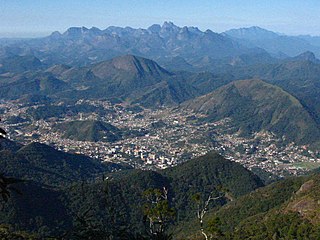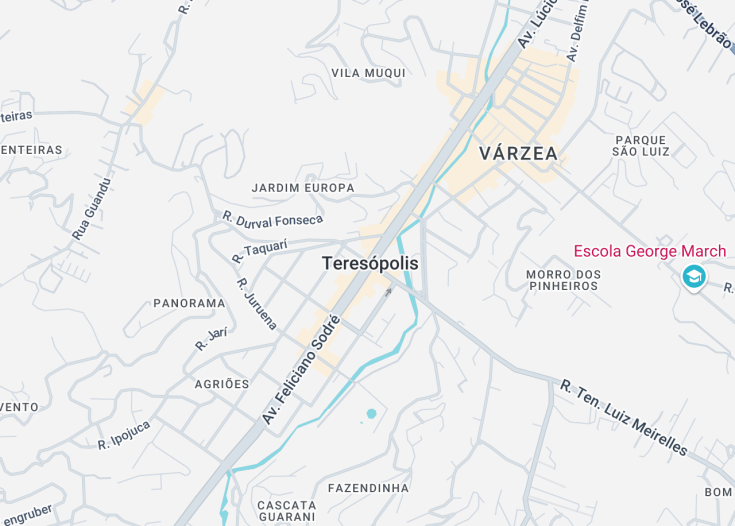Nestled amidst the lush, mountainous landscape of Rio de Janeiro state, Teresópolis is a serene retreat renowned for its natural beauty and tranquil atmosphere. This charming town offers a refreshing escape from Brazil’s bustling urban centers, with its stunning views of the Serra dos Órgãos National Park and the iconic Dedo de Deus peak.
Teresópolis also boasts a rich cultural scene, with museums and historical sites that provide insight into the local history and traditions, making it an ideal destination for nature lovers and cultural enthusiasts alike.
To make the most of your visit, plan for a hike in the Serra dos Órgãos National Park early in the morning to enjoy the breathtaking views and cooler weather.
Don’t miss the local cuisine in Teresópolis; trying the fresh trout dishes, a regional specialty, comes highly recommended for a true taste of the local flavors.
Teresopolis: Gateway to Brazil’s National Parks
| Country | Brazil |
| Time in Teresopolis | GMT-3 |
| Language spoken | Portuguese |
| Population | 182,008 (IBGE 2020) |
| Currency | Brazilian Real (R$ / BRL) |
| Airports |
|
Located in the mountainous region of Rio de Janeiro state, Teresopolis is a charming Brazilian town that acts as a true paradise for nature lovers and adventure seekers alike. Known for its picturesque landscapes and cooler climate, it is a popular retreat from the hustle and bustle of Rio de Janeiro city.
Where is Teresopolis?
Set in the Serra dos Órgãos in Brazil, Teresopolis sits at an elevation that provides breathtaking views and a cooler climate.
Distances:
| Route | Distance by car | Time by car |
|---|---|---|
| Rio de Janeiro to Teresopolis | 60 mi (97 km) | Approximately 1 hour 30 mins |
| São Paulo to Teresopolis | 298 mi (480 km) | Approximately 6 hours |
What is Teresopolis famous for?
Teresopolis is famed for the Serra dos Órgãos National Park, home to the iconic Dedo de Deus (God’s Finger) rock formation. It’s a haven for hikers, climbers, and those seeking the tranquility of nature.
History
The history of Teresópolis, a charming city nestled in the mountains of Rio de Janeiro state in Brazil, is a fascinating journey through time. From its pre-colonial roots to its establishment as a popular retreat for residents of Rio de Janeiro, Teresópolis showcases a rich tapestry of historical development.
Pre-Colonial Period – Before 1821
The area now known as Teresópolis was originally inhabited by the indigenous people, primarily the Tupi and Puri tribes. The lush landscapes and mountainous terrain provided ample resources for these early inhabitants, who lived in relative seclusion until the arrival of Portuguese colonizers.
The Imperial Era – 1821-1889
The official foundation of Teresópolis dates back to 1821 when George March, an Englishman commissioned by King John VI of Portugal, settled there. The city was initially named Freguesia de Santo Antônio de Paquequer. The region’s appeal grew after Brazil’s independence, especially among the Imperial family and the aristocracy who were drawn to its cooler climate and scenic beauty. In 1855, the region was renamed Teresópolis, in honor of Empress Teresa Cristina, the wife of Emperor Dom Pedro II.
Republican Period – 1889-Present
With the proclamation of the Republic in 1889, Teresópolis began to modernize. The 20th century marked significant development with the construction of roads and the establishment of rail connections, which facilitated the influx of tourists and settlers. Throughout the 20th century, Teresópolis evolved from a remote mountain retreat into a thriving urban locality. In recent years, the city has become famous as a hub for outdoor sports, especially hiking and climbing, given its proximity to the Serra dos Órgãos National Park.
Visit Teresopolis
What to see and do in Teresopolis, Brazil
Exploring Teresopolis offers a blend of natural beauty and cultural heritage. Key attractions include:
- Serra dos Órgãos National Park, known for its distinctive organ-shaped peaks and lush forests.
- The Mirante do Soberbo viewpoint, offering panoramic views of the city against a backdrop of dramatic mountain ranges.
- The Feirinha do Alto, a popular market where local handicrafts, organic produce, and traditional Brazilian street food can be enjoyed.
- The historical residence of the Brazilian imperial family, now a museum showcasing 19th-century artifacts and architecture.
Teresopolis also serves as an excellent base for hiking, climbing, and exploring the surrounding natural wonders.
Festivals and Events in Teresopolis
Teresopolis hosts several cultural and recreational events throughout the year. Notable among them are the Festa de São Pedro, a traditional festival held in June celebrating the city’s patron saint with parades and live music.
The Teresópolis Winter Festival, occurring in July, features a mix of musical performances and cultural exhibitions, attracting visitors keen on experiencing the local arts scene during the cooler months.
Best time to visit Teresopolis
The best time to visit Teresopolis is during the dry season from April to October, when the weather is most conducive for outdoor activities and exploring the city’s rich landscapes and cultural offerings.
Is Teresopolis worth visiting?
Teresopolis is unquestionably worth visiting for its unique blend of natural beauty, historical significance, and cultural vibrancy. The city’s proximity to Rio de Janeiro makes it an accessible escape into nature, ideal for those seeking tranquility or adventure amidst the scenic Serra dos Órgãos.
Whether you’re a history enthusiast, outdoor sports aficionado, or simply a lover of beautiful landscapes, Teresopolis offers something memorable for every visitor.
What are the best hiking trails in Teresopolis?
- Pedra do Sino Trail: This is the highest point in the Serra dos Órgãos National Park, offering spectacular views of the surrounding mountains and forests. The trail is challenging but rewards hikers with breathtaking scenery.
- Pedra da Tartaruga Trail: Ideal for families and beginners, this trail features unique rock formations and panoramic vistas. It’s less strenuous but equally rewarding with its rich flora and fauna.
- Travessia Petrópolis-Teresópolis: This is one of the most famous and challenging hikes in Brazil, connecting the cities of Petrópolis and Teresópolis. It takes about three days to complete, traversing rugged terrain with stunning views of the Brazilian Highlands.
These trails not only offer physical challenges but also provide a chance to connect with nature and appreciate the unique biodiversity of the region.
What is the climate like in Teresopolis?
What are the local culinary specialties in Teresopolis?
- Feijoada: A Brazilian stew of beans with beef and pork, which is a staple in the local cuisine.
- Trout: The region’s rivers are abundant with trout, and many local dishes feature this fresh fish either grilled or in stews.
- Pão de Queijo: Brazilian cheese bread, a delicious gluten-free snack that is particularly popular in Teresopolis due to its dairy farming.
- Doces de Leite: Sweet treats made from milk, often served as desserts or snacks.
These dishes represent just a glimpse of the diverse and delightful food available in Teresopolis. Various restaurants and markets in the city offer these local specialties, giving visitors a taste of authentic Brazilian cuisine.
Where can I experience local art and culture in Teresopolis?
- Museu Sobrado José Francisco Lippi: Here, visitors can delve into the history and cultural artifacts of the region, including exhibitions of local art and historical documents.
- Casa de Cultura Adolpho Bloch: Named after a famous Brazilian broadcaster and businessman, this cultural center hosts regular art exhibitions, theater performances, and music concerts, showcasing local talents.
- Feirinha de Teresópolis: An outdoor market that not only sells local handicrafts but also serves as a venue for cultural performances. This is a great place to shop for unique art pieces while enjoying traditional Brazilian music and dance.
These venues provide a vibrant look into the artistic and cultural life of Teresopolis, offering a variety of experiences for any visitor interested in local traditions.
Which local festivals are celebrated in Teresopolis?
- Festival de Inverno: Held during the winter months, this festival features a variety of musical performances, culinary showcases, and art exhibitions.
- Festa do Produtor Rural: This festival honors local farmers and producers, featuring agricultural displays, craft markets, and traditional food tastings.
- Festa de São Pedro: A traditional festival with religious processions, vibrant street fairs, and live entertainment, celebrating the patron saint of fishermen.
These festivals offer visitors a chance to experience the local culture, music, food, and traditions of Teresopolis, providing rich insights into the community’s way of life.
What wildlife can I expect to see in and around Teresopolis?
- Capuchin monkeys: Often spotted in the treetops, these playful primates are a common sight.
- Colorful birds: Including the Atlantic rainforest endemic, such as the golden lion tamarin and various species of toucans and parrots.
- Rodents and marsupials: Such as coatis and opossums which are commonly seen along the trails.
Birdwatching is especially rewarding here, with many species that are not found anywhere else in the world. While exploring, it’s important to respect the natural habitat of these animals and maintain a safe distance.
Are there any unique local crafts or products to look out for in Teresopolis?
- Handmade jewelry: Local artisans often use stones native to the region, creating distinctive pieces that reflect Brazil’s rich natural resources.
- Leather goods: High-quality leather products such as belts, bags, and shoes are common due to the region’s strong cattle farming tradition.
- Woven textiles: Handwoven rugs and other textiles featuring traditional patterns can be found in local markets and shops.
- Organic coffee: The mountainous terrain around Teresopolis is ideal for coffee growing, and several local plantations offer their own brands of rich, organically grown coffee.
Exploring local markets and small boutiques can be a rewarding way to find these items and bring home a piece of Teresopolis.
What are the best spots for photography in Teresopolis?
- Mirante do Soberbo: This viewpoint provides panoramic views of the Serra dos Órgãos mountain range, ideal for landscape photography.
- National Park waterfalls: The park houses several stunning waterfalls like the Veu de Noiva and God’s Finger, which make for dramatic subjects.
- Historical architecture: The neo-gothic architecture of St. Teresa’s Church provides captivating photographic opportunities, especially when framed against the mountainous backdrop.
These sites offer the chance to capture both the natural beauty and the unique cultural aspects of Teresopolis, making for a rewarding photographic journey.









